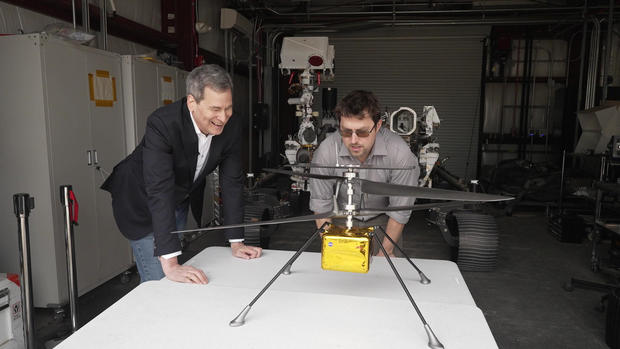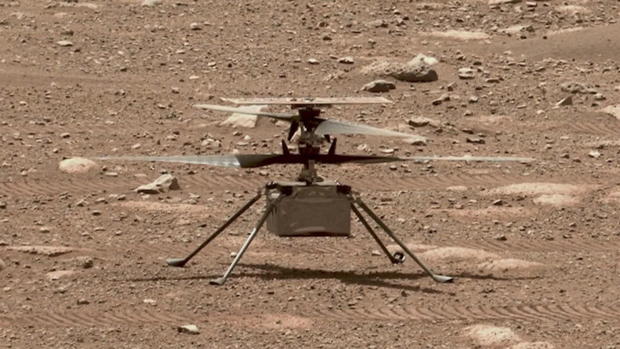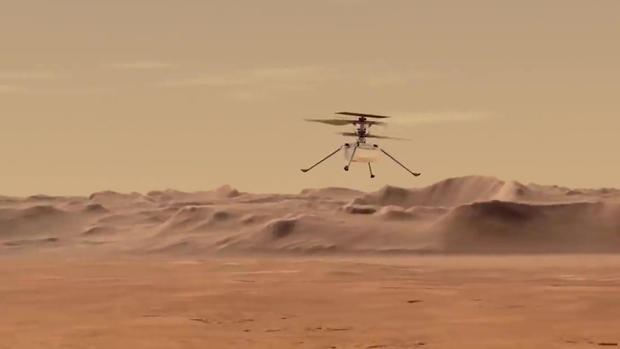
Ingenuity, NASA’s “little ‘copter that could” (and did!)
In 2020, NASA’s Perseverance rover launched for Mars with a stowaway: a tiny drone, created by NASA’s Jet Propulsion Laboratory in Pasadena, California.
The drone, named Ingenuity, was likened to a Wright Brothers’ plane on Mars, making the first flight on another planet. The entire drone had to be very light, because Mars has only 1% of the atmosphere of Earth; that’s hard for a flying machine. So, Ingenuity weighs only four pounds.
NASA classified Ingenuity as a tech demo: a low-budget, high-risk, side experiment, incorporating off-the-shelf parts to save money.
CBS News
But project manager Teddy Tzanetos said the idea of a stowaway technology demo, stored under the Rover, was not universally, enthusiastically embraced. “No, it was not! There were definitely people against it, not just concerned, but wholeheartedly against it and trying to prevent it from happening,” he said. “Mars 2020, to be fair, was a science mission: Go get some samples and prepare to bring those samples back home. Anything that’s not that is taking away resources.”
In the end, NASA decided that Ingenuity could fly, briefly – five times, tops, in the first 30 days. After that, no more distraction from the main mission.
the first flight of a powered aircraft on another planet! But the hardest part wasn’t flying; it was surviving the frigid Martian nights, which can fall to -80° Fahrenheit.
“The joke is that Ingenuity is a battery and a heater that happens to fly once in a while,” said Brown. “Most of the mass is battery, and most of that battery is actually spent heating.”
NASA
Despite the cold, the helicopter flew four more times – five flights in all. Mission complete! But then, an administrative miracle: “When people saw this thing flying and taking pictures, you know, I think everybody realized this is more than just a toy, this is a real flying machine,” said Håvard Grip, who was Ingenuity’s chief pilot. “NASA told us, ‘Hey, you guys get to continue, okay? Can you scout on behalf of the rover so we can see where the best ingress points are into this area?”
Ingenuity was no longer a tech demo. NASA promoted it to be the rover’s eye-in-the-sky, scouting ahead to help the rover choose its routes and destinations.
So, Ingenuity kept flying, kept beating its own records for distance, speed, altitude and duration. And not just for 30 days … for a hundred. Two hundred. Four hundred. Through the long Mars spring, summer and fall.
But then, winter came.
On Day 427 of the mission, there was radio silence from Ingenuity. “And so, the first thing you’re thinking is, ‘Okay, well, battery froze, everything broke, we’re probably dead,” said Brown. “Mission’s over, right?”
For three days, the team tried to get a response. And then, on the third day, another miracle. “Lo and behold, it came back and talked to us!” said Grip.
Tzanetos said, “In the morning when the sun rose and the system thawed and charged up enough, the electronics turned on. And we’d say, ‘Here’s your flight plan, go ahead and fly now late in the afternoon.’ And she’d do that flight, knowing full well – the controllers here on Earth – that she would freeze again the next day.”
So, Ingenuity froze to death every night all winter, and then thawed again in the morning? “Yeah, hundreds of times!” Brown laughed.
“It was like Groundhog Day,” said Tzanetos, “until finally you got through winter and you got to spring again.”
NASA
But even Ingenuity didn’t have an infinite supply of miracles. This past January, NASA got the bad news: Ingenuity had suffered a hard landing. “The top blade is clipped on one side and completely missing on the other,” said Brown. “We’re missing enough of the rotor system, there’s no way she’ll ever fly [again]. But I mean, this thing is still ticking. I talked to it this morning. We can still collect solar data. We can take pictures still.”
It’s true: Three years after its mission was supposed to end, the helicopter is still running, now as a ground station. We no longer receive its photos and measurements, because the Rover was its relay station, and the Rover has driven on. But Ingenuity could keep collecting data for decades, to be retrieved later.
Tzanetos said, “We have a phrase on the team: ‘WNDY: We’re not dead yet.'”
The “little copter that could” has changed NASA’s thinking forever. “We’ve been working on the next generation of helicopters for Mars – larger, more capable helicopters, [to] go to areas like a cliff wall, fly down a lava tube, go to the poles, go to the equator, you name it,” Tzanetos said.
NASA/JPL-Caltech/LANL/CNES/CNRS
As for that Wright Brothers analogy? Turns out the Mars stowaway helicopter harbored a stowaway of its own: According to Tzanetos, “The fabric used for the wings on the Wright Brothers flyer, we have a little piece about the size of a quarter underneath the solar panel of the helicopter, and it’s our little good luck charm, and ballast, for the baby.”
And did everybody in the chain of command know that this was there? “No, no, no. I’m sworn to secrecy about certain details for that, but no, the entire chain was not aware of that,” Tzanetos said.
In all, Ingenuity flew 72 times over the course of a thousand days, for a total of over two hours in the thin air of Mars, traveling more than 10 miles across the Martian surface. Brown credited “a small, scrappy team of engineers, very, very passionate about what they were doing.”
According to Tzanetos, “It has a special place in the history of NASA for being the first flight on another planet.”
“We’re all amazed; everybody here is amazed,” said Grip. “We didn’t expect this, and we’re just really proud of it.”
For more info:
Story produced by John Goodwin. Editor: Ben McCormick.
More
More
Source: cbsnews.com



